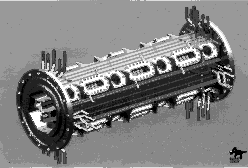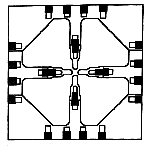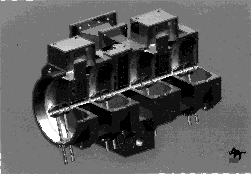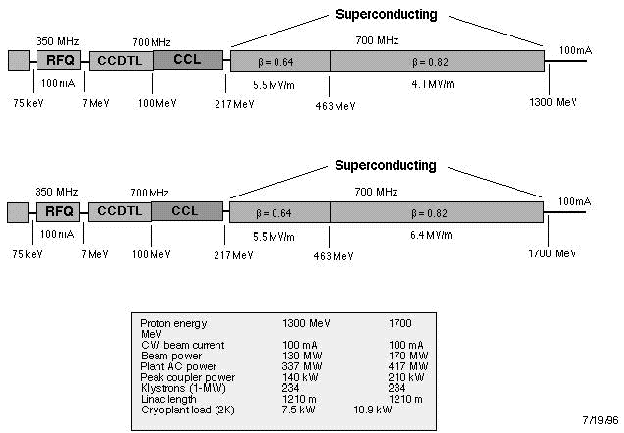The proposed accelerator production of tritium (APT)
project requires an accelerator that provides a cw proton beam
of 100 mA at 1300 MeV. Since the majority of the technical risk
of a high-current cw (continuous-wave, 100% DF) accelerator resides
in the low-energy section, Los Alamos is building a 20 MeV duplicate
of the accelerator front end to confirm design codes, beam performance,
and demonstrate operational reliability. We report on design details
of this low-energy demonstration accelerator (LEDA) and discuss
the integrated design of the full accelerator for the APT plant.
LEDA's proton injector is under test and has produced more than
130 mA at 75 keV. Fabrication is proceeding on a 6.7-MeV, 8-meter-long
RFQ, and detailed design is underway on coupled-cavity drift-tube
linac (CCDTL) structures. In addition, detailed design and technology
experiments are underway on medium-beta superconducting cavities
to assess the feasibility of replacing the conventional (room-temperature
copper) high-energy linac with a linac made of niobium superconducting
RF cavities.
A source of large numbers of neutrons has many applications [1], including the production of tritium. Nuclear fission reactors are traditional sources of neutrons, but a spallation process in which Å 1 GeV protons produce multiple neutrons, is an alternative that avoids a critical assembly and circumvents the environmental and safety challenges of a reactor. A suitable target/blanket design permits the creation of about 42 neutrons for every incident proton (at 1300 MeV).
The U.S. Department of Energy (DOE) is funding development of an accelerator-driven process (accelerator production of tritium, APT) for tritium production. Conceptual design of this production facility is being led by Los Alamos National Laboratory (LANL), with assistance by several other National Laboratories.
The proton driver for this APT facility is expected to be a cw (100% duty factor), 100 mA beam at 1300 MeV. Beam energy or current may be upgraded to 1700 MeV or 135 mA, respectively, to provide a 50% increase in neutron production. The unprecedented beam power of 130 (or 170) MW means that particular attention must be paid to structure cooling and to extremely low beam losses (less than 0.2 nA/m, above 100 MeV) to minimize component activation and permit "hands-on" maintenance of the linac.
In addition to the design of the entire accelerator, target/blanket assembly and tritium-extraction system, Los Alamos is proceeding with the design, setup and testing of a full-current prototype at approximately 20 MeV to confirm operational reliability of the accelerator front end. This low-energy demonstration accelerator (LEDA) will permit a full-power proton-beam test of the new, low-beta accelerating structures used on APT.
A majority (from about 100 MeV to the final energy) of the APT accelerator may be a conventional coupled-cavity linac (CCL) or side-coupled linac structure. Alternatively, a super-conducting linac assembly [2] could replace most of the CCL structure, to effect power savings and provide improved operational flexibility.
A conventional proton injector, including a number
of enhancements described below, is used to create a 75 keV, 115
mA beam. A radio-frequency quadrupole (RFQ) will be used to extend
the energy to about 6.7 MeV. A relatively new structure, the coupled-cavity,
drift-tube linac (CCDTL) [1] that combines the features of a conventional
DTL and the CCL will accelerate the protons to approximately 100
MeV.
LEDA will be constructed, assembled and tested at Los Alamos, and will be virtually identical to the first approximately 20 MeV of the APT accelerator. One of the few differences is that LEDA may have additional diagnostics to enable us to better characterize operation and measure details of the accelerated beam.
Beam tests will be done in a sequential fashion, as each linac structure is completed. Beam testing, commissioning and operation will extend over several years. Meanwhile, injector beam tests have been underway for more than a year. The RFQ should be completed and ready for beam about April, 1998. Beam operation with the first section of the CCDTL should start in the fall of 1998. Additional sections of the CCDTL will be added over the next couple of years and reliability testing and operations may extend past the turn of the century.
LEDA is intended to reduce risk in the design of the APT accelerator. Most of this risk reduction will be achieved by increasing our confidence in accelerator design and simulation codes, providing an improved basis for cost estimates, reducing uncertainty on beam-loss levels, verifying beam quality and performance, and in giving data on operational reliability. Table 1 indicates the primary objectives for the several stages of testing.
In addition, LEDA will provide an earlier opportunity for operator training, will serve as a "hot" spare for major low-energy components, and can be available as a prototype test bed.
Figure 1 shows a 20 MeV LEDA configuration, which
will be the primary emphasis for the first few years of operation.
However, we intend to assemble a full 40 MeV accelerator for better
testing CCDTL matching, halo formation, and the use of RF "super-modules".
In the event the APT accelerator is a room-temperature structure
and more neutrons are required, LEDA may be used to test a configuration
with a beam funnel, increasing the beam current to about 135 mA.

Table 1
LEDA Technical Objectives
Detailed measure of beam at RFQ match point
Match beam into the CRITS RFQ
Show fault recovery
Demonstrate long-term operation
Demonstrate variable current (and beam pulsing)
Demonstrate integrated cw operation of injector and RFQ
Confirm beam performance and benchmark simulations
Evaluate reliability and long-term operation
First test of klystron redundancy concept
Characterizes match between RFQ and CCDTL
Confirm beam performance and benchmark simulations
First use of 700 MHz rf power tube
Confirms matching across different structures
Tests multiple 700 MHz rf sources
Tests all critical beam dynamics
Allows test of full rf "super module"
Confirms formation of beam halo and control mechanisms
Confirms design parameters of high-energy linac
Measures beam performance through 3-gap and 2-gap structures.
Is the most cost-effective means of increasing beam current by 50--100%.
Allows measure of impact on beam quality by funnel.
LEDA will be assembled and tested in the former GTA (ground test accelerator) facility; this is being modified with the addition of more ac power and upgraded water-cooling systems.
An environmental assessment (EA) was prepared for LEDA and a FONSI (finding of no significant impact) was issued in April, 1996.
Figure 2 shows (by calendar year) the top-level schedule
for the several LEDA experimental activities. The primary immediate
focus of the LEDA program is to assemble and test the RFQ (stage
2, above). An equally important milestone for us is the testing
of the first section of CCDTL, confirming the beam match and proper
operation of the new 700 MHz klystrons.

Ion Injector
The LEDA injector was designed and partially assembled
with funding from a former program [3,4]. However, all testing
and refinements have been done with APT support. Figure 3 shows
the present configuration for testing.

The ion source for this LEDA injector was designed and built by a team at the Chalk River Laboratory (CRL) in Ontario, and is virtually identical to that used successfully on their cw proton accelerator program [5]. This source is particularly appealing because it has no filament, requires very little power Å600 W of 2.45 GHz microwaves), has very high gas efficiency (requires <0.1 torr l/s), is very stable, and has a high proton fraction (>90%). These excellent operating parameters lead us to speculate that this source can be far more reliable [6] than any previous cw proton source.
The LEDA beam extractor is very similar to one developed on the FMIT (Fusion Materials Irradiation Test) facility [7] at Los Alamos in the early 1980s. Detailed beam and extraction simulations are done with the PBGUNS code that self-consistently solves for the plasma-emission surface.
The low-energy beam transport (LEBT) and RFQ matching
section are very similar to the two-solenoid system used on the
GTA (ground test accelerator) [8] to provide a high-quality, tunable
beam for RFQ injection. Space-charge neutralization in most of
the transport region compensates for 98% of the beam space charge.
In addition to vacuum pumps and non-interceptive diagnostics,
the LEBT will include steering and focus magnets, an insertable
beam stop, a variable iris for current control, and a fast deflector
for beam pulsing.
Operation with the pictured injector test stand has
demonstrated the required cw (DC) 75 keV beams with more than
110 mA of protons, with a normalized transverse emittance of 0.2
' mm-mrad. Design and testing details of the LEDA injector are
covered in a companion paper [9] at this conference.
Although the RFQ is by now a commonplace accelerator, the APT and LEDA RFQ differ from previous structures in a few important respects. LEDA's eight-meter-long, 350-MHz RFQ will be built in eight sections, configured as four separately tunable segments. Structurally, it is a solid brazed structure with two minor vanes and two major vanes. Predicted rf power losses on the interior surfaces of this solid copper (OFE) assembly are 1.27 MW, necessitating very effective water cooling. Full-current beam acceleration will require a total of 2.0 MW, so either two or three 1.0 MW rf klystrons will be needed to supply rf power. Static slug tuners will be adjusted during final tuning, then custom machined to size and bolted into place. During operation, resonance control will be through control of cooling water temperature.
A full-scale (8-meter long), low-power,
"cold-model" was built and used to verify structure
tunability and to confirm the details of the vane undercuts. In
addition, a short length of an "engineering model" was
built, brazed and tested to confirm the stackup of errors and
to measure the structural rigidity.

The LEDA RFQ is in concurrent detailed
design and fabrication. Machining is nearly complete on the first
of eight sections (Fig. 5), most vane skirts have been roughed
out, samples of the sixteen different vane tips were completed,
and a start was made on the brazing cycles.


Of the eight RFQ sections shown in
Figure 5, three (A1, A2 & C2) will have 12-each vacuum pumping
ports, three other sections (B1, C1 & D1) will support four-each
rf coupling ports and irises, while two sections (B2 & D2)
will include neither vacuum nor rf ports. Power from each of the
nominal 1--1.3 MW rf klystrons will be split four ways to keep
the power applied to each rf window to a conservative 250 kW.
Each of the four major copper structures in each of the eight
sections will require 5 major machining steps and three braze
steps.

Adequate cooling is imperative for
this cw, high-power RFQ. A controlled-temperature water flow of
1300 gpm (82 l/s) is needed for RFQ cooling. After initial tuning,
RFQ section resonance is adjusted by control of the cooling-water
temperature.
Design details and advantages of the 700-MHz coupled-cavity drift-tube linac are described in [10]. The CCDTL was invented to capture the major benefits of both the DTL structure and the ubiquitous CCL (coupled-cavity linac), both of which have seen extensive operation. The CCDTL promises to provide a higher shunt impedance than the DTL and has all transverse focusing magnets outside the accelerating cavities, relaxing alignment tolerances on the cavities. This configuration also allows many cells to be brazed into a solid one-piece structure, again with resonance control effected by cooling-water temperature control.
Both a half-scale and a full-scale cold model of several contiguous CCDTL cells have been constructed to permit code comparisons, refinement of tuning procedures, and optimizing coupling-cell configuration. Our standard design codes, including PARMILA, have been modified [11] (and bench-marked) to accommodate the symmetric CCDTL accelerating cavities.
LEDA will provide the first opportunity to test the
CCDTL structure with high rf power and with beam. Like the RFQ,
the CCDTL will be made of solid OFE copper. Singlet electromagnetic
quadrupoles will be assembled in a split configuration to facilitate
installation on the structure without breaking vacuum. Dipolar
steering windings will be added on the quads, and used with beam-position
monitors (BPMs) inside the magnet bore to facilitate beam steering
through the linac.

Longitudinal matching (Fig. 9) between the RFQ and
CCDTL will be done by adjustment of the synchronous phase in the
last few RFQ cells and the first several CCDTL cells. The two
structures will abut, creating a maximum drift distance without
acceleration of only 2.5 bl.
This matching feature is just one of many designed to control
halo growth in the accelerated beam. [12]

Extensive end-to-end beam-dynamics simulations (usually
with 100,000 particles) have been run to confirm that beam quality
is preserved in this design. Special attention is paid to the
formation and behavior of the beam halo [13], because of our concern
about minimizing beam loss at higher energies. These computer
runs show a very modest beam loss below 20 MeV, mostly near 11
or 12 MeV. However, no particles are seen outside a radius of
about 6.7 rms at higher energies. At higher energies, bore-to-rms
beam ratios are at least 25:1 for the room-temperature structure
and 40:1 for the superconducting structure. These simulation results
increase our confidence that beam losses will not exceed 10 nA/m,
and that "hands-on" maintenance will be feasible.
Development of beam commissioning procedures
will be an important part of LEDA. Primary LEDA commissioning
objectives include:
Verification of all design and simulation codes and models.
Determination of best conditioning and turn-on procedures.
Demonstration of beam performance; current, quality, stability.
Measure of halo formation, causes and elimination.
Measure of operational reliability and failure predictions.
Monitoring of matching between structures.
Determination of what diagnostics are needed in what locations.
Development of optimum commissioning
procedures for use in a plant or production accelerator.
Initial beam commissioning will be
started at a low duty factor, at a rep rate of 5 or 10 pps, and
with pulse lengths of only about 100 µs. This will help prevent
equipment damage, accelerator activation and will facilitate use
of conventional diagnostics for initial tune-up. We expect to
use a cw mode with variable current (starting at about 1 mA) for
start-up of the operational beam. On-line diagnostics with the
operational cw beam will be limited to use of non-interceptive
diagnostics, relying heavily on video-profile cameras and BPMs
(beam-position monitors) sensitive to the 350 MHz fundamental
modulation.
A 700-MHz standard-configuration side-coupled
linac will be used from the end of the CCDTL (about 100 MeV) to
either the end of the accelerator, or to the match point into
a super-conducting structure. Based on preliminary optimizations,
the favored transition point to the SCRF structure is about 217
MeV (Figure 10).
A superconducting section of accelerator is being considered for use from approximately 217 MeV to the final APT energy. Use of a superconducting linac structure will dramatically reduce the required rf power for the plant, and also promises operational advantages in terms of stability and flexibility. One expected advantage is operational availability, as any single non-functioning module can be detuned and taken out of service. Details of the proposed superconducting structure are given in a companion paper [14].
The proposed complete APT accelerator configuration
is shown in Fig 10. The exact transition point between the low-energy
room-temperature structures and the high-energy super-conducting
structures will be made later, after a full optimization trade
is made between cost savings, operational advantages, beam quality
and design risk. Detailed discussions are given in reference [2].

Support for all of the APT program (including LEDA) is provided by the US Department of Energy, Defense Programs (DP) Office. Design of the APT accelerator is being led by a team at Los Alamos National Laboratory, mainly from AOT (Accelerator Operations and Technology) and ESA (Engineering Services and Analysis) divisions. Assistance is provided by Lawrence Livermore National Laboratory (LLNL), Brookhaven National Laboratory (BNL) and Sandia National Laboratory (SNL). A partnering and much of the balance-of-plant (BOP) work is done by personnel from the Savannah River Site (SRS). SRS is the preferred site for the APT production plant, if APT is the selected technology. At the time of publication, a selection is scheduled for choice of a Prime contractor, who will be responsible for preliminary and final design and construction of the APT plant.
Design efforts on APT and LEDA benefit greatly from previous programs, especially the FMIT (Fusion Materials Irradiation Test) and ground test accelerator (GTA) development at Los Alamos, and the cw proton development at Chalk River Laboratories (CRL). We wish to express our sincere appreciation to all those who shared their knowledge from cw linac development.
I want to specially acknowledge the
key task leaders on the major LEDA systems. Joe Sherman is responsible
for the development of the proton injector. Dale Schrage is pushing
the design and fabrication of the RFQ. Rick Wood is leading the
construction of the CCDTL. Dan Rees is overseeing the procurement,
design, assembly and testing of the high-power rf systems. Jim
Stovall is leading the beam dynamics simulations and preparing
a beam commissioning plan. Without the hard work and dedication
of these folks and many others doing equally important, smaller
tasks, LEDA would not be possible.
[1] G. P. Lawrence, "Transmutation and Energy
Production with High-Power Accelerators". Proc. 1995 Part.
Accel. Conf. p35.
[2] G. Lawrence, et al, "Conventional and Superconducting
RF Linac Designs for the APT Project". Proceedings, 1996
Linac Conf.
[3] J. D. Schneider, E. Meyer, R. R. Stevens, L. Hansborough and J. Sherman, "Design and Testing of a DC Ion Injector Suitable for Accelerator-Driven Transmutation". Proc. 1994 International Conference on Accelerator-Driven Transmutation Technologies and Applications. p439
[4] J. Sherman, R. R. Stevens, J. D. Schneider and
T. Zaugg, "Direct-Current Proton-Beam Measurements at Los
Alamos". Proc. 1994 International Conference on Accelerator-Driven
Transmutation Technologies and Applications. p432
[5] T. Taylor and J. S. C. Wills, "Enhanced
High-Current ECR Proton Source". Proc. 1992 Linear Accel
Conf. p350.
[6] J. Sherman, D. Hodgkins, P. Lara, J. D. Schneider
and R. R. Stevens, Jr., "Lifetime Test on a High-Performance
DC Microwave Proton Source". Proc. 1995 Particle Accelerator
Conf., Dallas, p867.
[7] W. D. Cornelius, "CW Operation of the FMIT
RFQ Accelerator", Proc 1985 Part. Accelerator Conference.
p3139.
[8] R. R. Stevens, "High-Current, Negative-Ion-Beam
Transport". Sixth Intl. Symposium on Production and Neutralization
of Negative Ions and Beams, AIP Conf. Proc. # 287, Particles and
Fields Series 53, Nov., 1992, p646.
[9] J. D. Sherman, et al, "Development of a
110-mA, 75 keV Proton Injector for High-Current, CW Linacs".
Proceedings, 1996 Linac Conf.
[10] J. H. Billen, S. Nath, J. E. Stovall, H. Takeda,
R. L. Wood, and L. M. Young, "A Versatile, High-power Proton
Linac for Accelerator-Driven Transmutation Technologies".
Proc. 1995 Particle Accelerator Conf., Dallas, p1137.
[11] H. Takeda and J. E. Stovall, "Modified
PARMILA Code for New Accelerating Structures". ". Proc.
1995 Particle Accelerator Conf., Dallas, p2364.
[12] J. H. Billen, H. Takeda, and L. Young, "Smooth
Transverse and Longitudinal Focusing in High-Intensity Ion Linacs".
Proceedings, 1996 Linac Conf.
[13] R. D. Ryne, S. Habib and T. P. Wangler, "Halos
of Intense Proton Beams". Proc. 1995 Particle Accelerator
Conf., Dallas, p3149.
[14] K. C. D. Chan, "Conceptual Design of a
Superconducting, High-Intensity Proton Linac". Proceedings,
1996 Linac Conf.